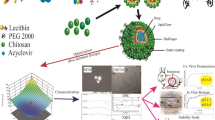Abstract
The purpose of this research was to prepare acyclovir niosomes in a trial to improve its poor and variable oral bioavailability. The nonionic surfactant vesicles were prepared by the conventional thin film hydration method. The lipid mixture consisted of cholesterol, span 60, and dicetyl phosphate in the molar ratio of 65:60:5, respectively. The percentage entrapment was ∼11% of acyclovir used in the hydration process. The vesicles have an average size of 0.95 µm, a most probable size of 0.8 µm, and a size range of 0.4 to 2.2 µm. Most of the niosomes have unilamellar spherical shape. In vitro drug release profile was found to follow Higuchi’s equation for free and niosomal drug. The niosomal formulation exhibited significantly retarded release compared with free drug. The in vivo study revealed that the niosomal dispersion significantly improved the oral bioavailability of acyclovir in rabbits after a single oral dose of 40 mg kg−1. The average relative bioavailability of the drug from the niosomal dispersion in relation to the free solution was 2.55 indicating more than 2-fold increase in drug bioavailability. The niosomal dispersion showed significant increase in the mean residence time (MRT) of acyclovir reflecting sustained release characteristics. In conclusion, the niosomal formulation could be a promising delivery system for acyclovir with improved oral bioavailability and prolonged drug release profiles.
Similar content being viewed by others
References
Erlich KS. Management of herpes simplex and varicella-zoster virus infections.West J Med. 1997;166:211–215.
Miranda P, Krasny HC, Page DA, Elion CB. Species differences in the disposition of acyclovir.Am J Med. 1982;73:31–35.
de Miranda P, Blum MR. Pharmacokinetics of acyclovir after intravenous and oral administration.J Antimicrob Chemother. 1983;12:29–37.
Vergin H, Kikuta C, Mascher H, Metz R. Pharmacokinetics and bioavailability of different formulations of acyclovir.Arzneim Forsch. 1995;45:508–515.
Amidon GL, Lennernas H, Shah VP, Crison JR. A theoretical basis for a biopharmaceutic drug classification: the correlation of n vitro drug product dissolution and in vivo bioavailability.Pharm Res. 1995;12:413–420.
US FDA. Waiver of in vivo bioavailability and bioequivalence studies for immediate-release solid dosage forms based on a biopharmaceutics classification system. 2000; Available at: www.fda.gov/cder/guidance/2062dft.pdf. Accessed November 2, 2007.
Avdeef A. pH-metric solubility. I. Solubility-pH profiles from Bjerrum plots, Gibbs buffer and pKa in solid state.Pharm Pharmacol Commun. 1998;4:165–178.
Lund W.The Pharmaceutical Codex, Principles and Practice of Pharmaceutics. London, UK: The Pharmaceutical Press; 1994.
Krenitsky TA, Hall WW, de Miranda P, Bauchamp LM, Schaeffer HJ, Whiteman P. 6- Deoxyacyclovir: a xanthine oxidase-activated prodrug of acyclovir.Proc Natl Acad Sci USA. 1984;81:3209–3213.
Lycke J, Malmestrom C, Stahle L. Acyclovir levels in serum and cerebrospinal fluid after oral administration of valacyclovir.Antimicrob Agents Chemother. 2003;47:2438–2441.
Luengo J, Aranguiz T, Sepulveda J. Preliminary pharmacokinetic study to different preparations of acyclovir with β-cyclodextrin.J Pharm Sci. 2002;91:2593–2598.
Azmin MN, Florence AT, Handjani-Vila RM, Stuart FB, Vanlerberghe G, Whittaker JS. The effect of non-ionic surfactant vesicles (niosome) entrapment on the absorption and distribution of methotrexate in mice.J Pharm Pharmacol. 1985;37:237–242.
Peh KK, Yuen KH. Simple high-performance liquid chromatographic method for the determination of acyclovir in human plasma using fluorescence detection.J Chromatogr B. 1997;693:241–244.
McIntosh TJ. The effect of cholesterol content on the structure of phosphatidylcholine bilayers.Biochim Biophys Acta. 1978;51:43–58.
Yoshioka T, Sternberg B, Florence AT. Preparation and properties of vesicles (niosomes) of sorbitan monoesters (span 20, 40, 60, 80) and a sorbitan triester (span 85).Inter J Pharmaceut. 1994;105:1–6.
Schwender RA, Asanger M, Weder HG. N-alkyl-glucosides as detergents for the preparation of highly homogenous bilayer liposomes of visible size (60–240 nm) applying defined rates of detergent removal by dialysis.Biochem Biophys Res Commun. 1981;10:1055–1062.
Brigden D, Fowle A, Rosling A. Collier LH, Oxford J, eds.Developments in Antiviral Therapy. London, UK: Academic Press; 1980:53–62.
Meadows KM, Dressman JB. Mechanism of acyclovir uptake in rat jejunum.Pharm Res. 1990;7:299–303.
Author information
Authors and Affiliations
Corresponding author
Additional information
Published: December 14, 2007
Rights and permissions
About this article
Cite this article
Attia, I.A., El-Gizawy, S.A., Fouda, M.A. et al. Influence of a niosomal formulation on the oral bioavailability of acyclovir in rabbits. AAPS PharmSciTech 8, 106 (2007). https://doi.org/10.1208/pt0804106
Received:
Revised:
Accepted:
DOI: https://doi.org/10.1208/pt0804106




